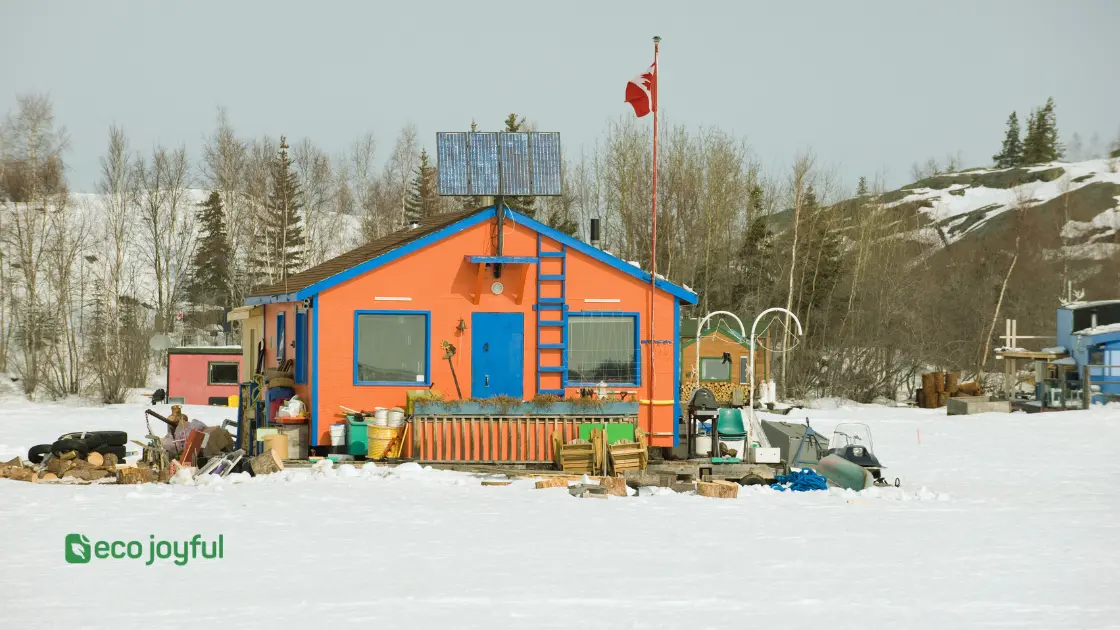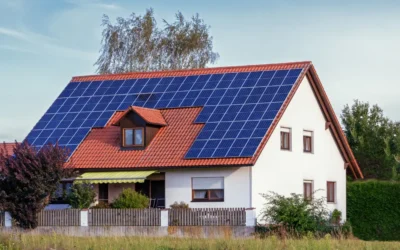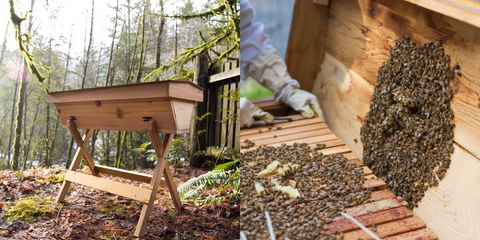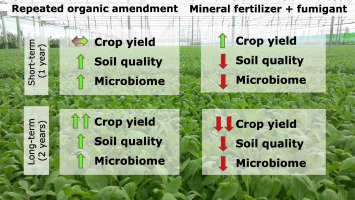To build your own raised garden bed, first, choose a location and size that suits your needs. Then, gather materials such as lumber, screws, and soil.
Building your own raised garden bed is a great way to customize your gardening experience while also providing numerous benefits. Raised garden beds can help improve soil quality, reduce weeds, and make it easier to plant and maintain your garden.
To get started, choose a location for your garden bed and determine the size that will best suit your needs. Next, gather the necessary materials including lumber, screws, and soil. With a few simple steps, you can have a beautiful raised garden bed ready for planting in no time. We’ll walk you through the process of building your own raised garden bed.
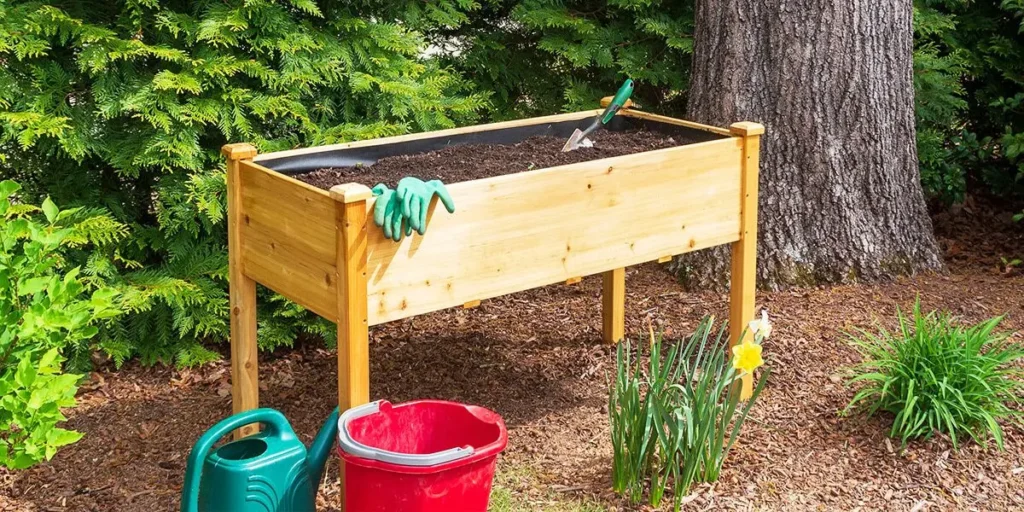
Credit: platthillnursery.com
Table of Contents
Why Build A Raised Garden Bed
If you’ve ever wanted to start a garden but found yourself limited with yard space, or don’t want to dig up your lawn – building a raised garden bed could be the solution you’re looking for. A raised garden bed is a gardening method that uses a contained area to control soil quality, drainage, pest control, and maximizes garden space.
Benefits Of Raised Garden Beds
Building your own raised garden bed has numerous advantages that make it a smart option for any gardener. Here are a few benefits:
Maximizing Garden Space
By building a raised garden bed, you’ll be creating a more efficient use of your available space. Instead of trying to plant in between existing plants or in random spots in your yard, you can create a designated area for your garden that maximizes plant growth and minimizes weeding. It’s a great way to elevate what you can grow in small spaces and create an organized and manageable garden area.
| Maximizing Garden Space Tips | |
|---|---|
| Choose a sunny location for your garden bed | Moisture control is essential – avoid spot that are too dry or too wet |
| Consider vertical gardening techniques – not all plants have to be at ground level | Add wheels to the bottom of your raised bed so you can move it around easily within your yard |
Sustained Soil Quality
Another advantage of raised garden beds is the ability to maintain healthy, nutrient-rich soil. Traditional gardens can suffer from soil erosion, compaction, and nutrient depletion. But, a raised bed allows gardeners to control the type and origin of soil in the bed. Additionally, you can add soil conditioners like compost and manure to keep the soil healthy and fertile.
Pest Control
Garden pests can be a frustrating headache. When you build a raised garden bed, you can add a layer of protection to your plants. By creating a physical barrier between your plants and the ground, you can limit the number of insects and other creatures that can damage your garden. You can also add organic pest control methods like planting companion plants, using insect-repelling herbs, or using organic sprays.
Easy on Your Back
Traditional gardening can be hard on your body, especially if you’re bending and kneeling for extended periods. With a raised garden bed, you can customize the height of the bed to fit your body, making it easier to plant, maintain, and harvest your crops.
- Tip: build your raised bed to be about waist-high for an easy and comfortable working experience.
- Another benefit of a raised garden bed is the ability to reduce the strain on your back and knees.
Easier to Manage
The confined area of a raised garden bed makes it easier to manage and maintain compared to a traditional garden. With less ground to cover, you can spend less time weeding and more time harvesting your crops. You can also rotate your crops, adjust soil acidity, and control irrigation more precisely.
- Consider adding a drip irrigation system to your raised bed for better water management.
- Build a trellis or create extra support for climbing plants to maximize space utilization and make it easier to harvest fruits and vegetables.
A raised garden bed is a smart and practical way to start your gardening journey. Not only does it maximize your garden space, but it also provides a way to control soil quality, manage pests, and lessen the physical strain on your body. Start planning your own raised garden bed and enjoy all the benefits of this efficient and rewarding gardening method.
Choosing The Right Location
Selecting the appropriate location is a crucial aspect when it comes to building your raised garden bed. Factors like sunlight, soil type, and accessibility to water need to be considered. Ensure that your location can accommodate the size of your garden bed and the plants you intend to grow.
Choosing the right location is a crucial step when it comes to building your own raised garden bed. The success of your garden depends on this decision, as it can impact the amount of sunlight, accessibility, and drainage your plants receive. In this post, we’ll go over the different aspects you need to consider before setting up your raised garden bed in your desired location.
Sun Exposure
One of the first things you need to keep in mind is the sun exposure in your chosen location. Most fruits and vegetables need full sun to survive and thrive, which means they need a minimum of 6 hours of direct sunlight every day. Therefore, it’s vital to select a spot that receives sunlight for most of the day. If the location you have in mind doesn’t receive enough sun, you can consider installing some shade cloths over your raised garden bed.
Accessibility
Your garden bed should be conveniently situated and easily accessible. While it’s tempting to put your garden bed in the farthest corner of your backyard, it can make maintaining and harvesting your plants a difficult and time-consuming task. Therefore, ensure that you choose a location that’s easy to access from all angles. You should have enough space to walk around your garden bed and reach all the plants without stepping inside the bed.
Drainage
The last aspect to keep in mind is the drainage of the location you have chosen. It’s ideal to build your garden bed on a slight slope that will allow excess water to flow away from the plants. If you have selected a spot that is slightly flat, you can add some drainage pipes or dig the soil deeper to allow proper drainage. Poor drainage can lead to soil erosion, root rot, and stunted plant growth.
In conclusion, choosing the right location is crucial to ensure the success of your raised garden bed. By considering sun exposure, accessibility, and drainage, you’ll be able to set up your garden with the best possible conditions for your plants to grow and thrive.
Materials Needed
To build your own raised garden bed, you will need some basic materials. These include wood planks, screws, a saw, a drill, soil, compost, and plants or seeds. Depending on the size and location of your garden bed, you may also need a shovel, a level, and a weed barrier.
Materials Needed:
Building a raised garden bed requires a few essential materials that can be easily found at any hardware store. These materials include wood, hardware cloth, soil, compost and mulch. Here is a breakdown of each material needed for building a raised garden bed.
Wood:
The first and most important material needed for constructing a raised garden bed is wood. You should purchase untreated lumber, as treated lumber can contain chemicals that may contaminate your soil. The type of wood you choose is important, as it will affect the durability and lifespan of your garden bed. Cedar, redwood, and cypress are excellent choices, as they are naturally rot-resistant and can last for many years. You will need the following amounts of lumber:
– 4 pieces of 2x10x8 or 2x12x8 lumber for the sides of the bed
– 4 pieces of 4x4x12 lumber for the bed corners
Hardware Cloth:
Hardware cloth is a heavy-duty wire mesh that is used to keep rodents and other pests from entering your garden bed. You will need to wrap the hardware cloth around the bottom of your garden bed before adding soil. Here’s what you will need:
– 3 feet of 1/2-inch hardware cloth
Soil:
The quality of your soil is critical to your plants’ health, and you should choose a high-quality soil mix that is rich in nutrients and organic matter. You can buy pre-mix soil or make your own by combining equal parts of topsoil, compost, and sand. Here’s what you will need:
– Approximately 50 cubic feet of soil mix
Compost:
Compost is a valuable addition to any garden, as it provides vital nutrients to your plants. You can buy compost at your local garden center or make your own by composting your kitchen waste and garden debris. Here’s what you will need:
– Approximately 20 cubic feet of compost
Mulch:
Mulch is a layer of organic material that is placed on top of your soil to help retain moisture and suppress weed growth. You can use a variety of materials as mulch, including shredded leaves, straw, and wood chips. Here’s what you will need:
– Approximately 6 cubic feet of mulch
Now that you have all the materials, you are ready to start building your own raised garden bed.
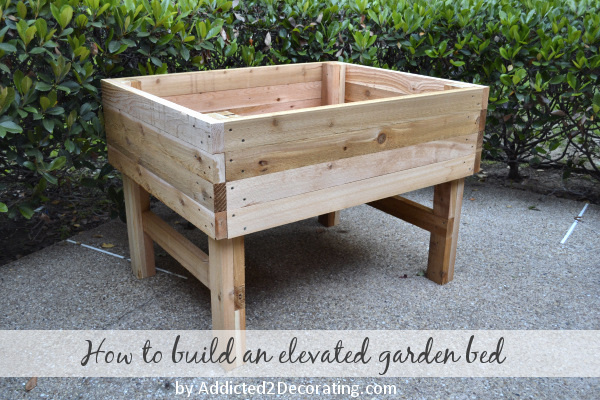
Credit: www.addicted2decorating.com
Building The Raised Garden Bed
Building your own raised garden bed can be a fulfilling and rewarding experience. Not only will you get to design and customize it to fit your specific needs, but you’ll also be able to reap the benefits of having fresh produce right in your backyard. In this section, we’ll take you through the steps of building the raised garden bed, including cutting the wood, drilling holes, and assembling the bed.
Cutting The Wood
The first step in building your raised garden bed is to cut the wood to the appropriate length and width. You can use a handsaw or circular saw to cut the wood, depending on your preference. Make sure to measure the dimensions carefully to ensure that your garden bed is the correct size. It’s also a good idea to sand the edges of the wood to prevent any splinters or rough surfaces.
Drilling Holes
Drilling holes is the next step in building your raised garden bed. These holes will allow for drainage and prevent water from pooling in the bed. Use a drill to make several small holes in the bottom of the bed, evenly spaced apart. Depending on the size and length of the bed, it may be necessary to add additional holes for proper drainage.
Assembling The Bed
Finally, it’s time to assemble the bed. Start by laying out the cut pieces of wood in the desired shape and position. Use corner brackets to secure the pieces together and ensure that the bed is sturdy and level. It’s important to double-check the measurements and alignments as you assemble the bed to make sure that everything fits together correctly.
Building your own raised garden bed can be a fun and rewarding DIY project that offers numerous benefits. By following these steps and taking your time to carefully measure and assemble the bed, you’ll be on your way to a successful and bountiful garden.
Preparing The Area
One of the essential steps in building your raised garden bed is to prepare the area. Clear away any debris, level the ground, and add a layer of weed barrier to keep unwanted plants from growing underneath. These steps will ensure a stable and healthy foundation for your garden.
To start building your own raised garden bed, you need to first prepare the area. This involves removing grass, leveling the ground, and ensuring the area is ready for your garden bed. Here’s what you need to do:
Removing Grass
The first step is to remove any grass or vegetation in the area where you’ll be placing your garden bed. You can do this by using a shovel to cut the grass and then removing it. Alternatively, you can use a weed killer to kill the grass and vegetation. Make sure to wear protective gloves and clothing if you choose to use a weed killer.
Leveling The Ground
After you have removed the grass, the next step is to level the ground. You want to ensure that the ground is level to prevent your garden bed from tilting or sinking. Use a rake or hoe to smooth out any bumps and fill in any holes to make the ground even.
Building A Base
Once you have leveled the ground, you can build the base of your garden bed. This can be done using bricks, wood planks, or even cinder blocks. Place the materials in a rectangle shape, ensuring that the corners are square and the sides are even.
Finally, you need to fill the raised garden bed with soil. Make sure to use a high-quality soil mix that is rich in nutrients. You can add additional compost or fertilizers to give your plants an extra boost.
In conclusion, preparing the area is an important first step in building your own raised garden bed. By following these simple steps, you can ensure that your garden bed is level, stable, and ready for your plants.
Filling The Bed
Building a raised garden bed is an excellent way to enhance your gardening experience. Filling the bed with proper soil, compost, and nutrients for your plants is essential for success. With these steps, you can build your own bed and enjoy fresh produce all season long.
One of the most essential parts of building a raised garden bed is filling it properly. Filling the bed with the right materials ensures that your plants have the nutrients they need to thrive. In this article, we will go over the three key steps to filling your raised garden bed: adding soil, mixing in compost, and applying mulch.
Adding Soil
The first step in filling your raised garden bed is to add soil. The quality of your soil is crucial to the success of your plants, so it’s important to choose the right type. Avoid using low-quality topsoil, as it may contain weed seeds and other impurities that can harm your plants.
Instead, opt for a high-quality garden soil that is specifically formulated for raised beds. This type of soil is typically a mixture of topsoil, compost, and other organic matter. When adding the soil to your raised bed, be sure to fill it to the top, leaving only a few inches of space at the top for mulch.
Mixing In Compost
Compost is a crucial ingredient for any successful garden. When added to your soil, it provides essential nutrients for your plants, helps to retain moisture, and improves soil structure. To mix in compost with your soil, you can either layer it on top of the soil or mix it in with a shovel or rake.
If you’re making your own compost, you should ensure that it is fully decomposed before adding it to your garden bed. If you’re using store-bought compost, make sure to read the label carefully and choose a product that is suitable for your plants.
Applying Mulch
Applying mulch is the final step in filling your raised garden bed. Mulch helps to conserve soil moisture, suppress weeds, and regulate soil temperature. There are a variety of different materials you can use for mulch, depending on your needs and preferences.
Some popular choices for mulch include shredded leaves, straw, grass clippings, and wood chips. When applying mulch, be sure to spread it evenly over the top of your soil, leaving a small gap around the base of your plants to prevent moisture buildup.
By following these simple steps for filling your raised garden bed, you can ensure that your plants have the nutrients and support they need to thrive. With the right soil, compost, and mulch, your garden bed will be a healthy and productive space to grow your favorite plants.
Choosing What To Plant
If you’re considering starting a garden, building a raised garden bed is a great idea. Raised garden beds can provide better soil drainage, reduce soil erosion, and make it easier to control weeds. Once you’ve built your raised garden bed, the next step is to decide what to plant.
Consider Plant Spacing
When choosing what to plant in your raised garden bed, it’s important to consider plant spacing. Plants that are spaced too closely together can compete for resources and become stunted. On the other hand, plants that are spaced too far apart can waste valuable garden space.
As a general rule, plants that produce fruit or vegetables should be spaced 18 to 24 inches apart in all directions. Leafy vegetables can be spaced closer together, about 6 to 12 inches apart. Vining plants, like tomatoes and cucumbers, should be spaced about 24 to 36 inches apart.
Sun And Water Requirements
Another important factor to consider when choosing what to plant in your raised garden bed is the sun and water requirements of your plants. Most vegetable plants require at least six hours of sunlight per day, so be sure to choose a location for your garden bed that gets plenty of sun.
You’ll also need to make sure your plants get enough water. Vegetables generally need at least 1 inch of water per week, either from rain or irrigation. If you live in an area with hot, dry summers, you may need to water your garden more frequently.
Choose Your Plants
Now that you know how much space your plants need and how much sun and water they require, it’s time to choose what to plant in your raised garden bed. Some easy-to-grow vegetables for beginners include:
- Tomatoes
- Zucchini
- Lettuce
- Cucumber
- Radish
These vegetables are all relatively easy to care for and can be grown successfully in a raised garden bed. Be sure to do your research and choose plants that will thrive in your climate and soil type.
Now that you know the basics of what to plant in your raised garden bed, it’s time to start planning your garden! With a little bit of planning and care, you’ll be able to enjoy fresh, homegrown vegetables all summer long.
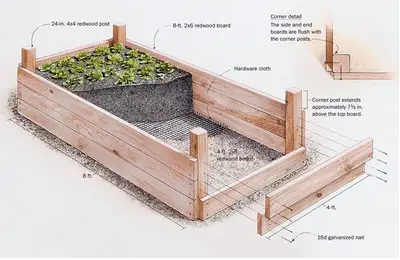
Credit: www.wilsonbrosgardens.com
Maintaining Your Raised Garden Bed
Maintaining your raised garden bed is crucial for a flourishing garden. Regularly watering and fertilizing your plants, removing weeds and dead foliage, and replacing soil as needed are essential tasks to keep your garden beds healthy and productive. Building your own raised garden bed allows for customization and easier maintenance.
Once you have built your raised garden bed, maintaining it is crucial for a successful harvest. Here are some tips on how to keep your garden looking and producing its best.
Watering
Regular watering is essential for the health of your plants. Water your raised garden bed every day, especially during hot and dry weather. Make sure to water the plants at their base, avoiding the leaves. This helps prevent water from evaporating, allowing the roots to absorb the water more efficiently.
Weeding
Weeds can be a real problem in a raised garden bed. They can quickly spread among your plants and compete for resources, depriving them of water and nutrients. Regular weeding is essential to keep your garden healthy. Pull weeds by hand or use a hoe to remove them when they are still small. Avoid using chemicals that can harm the soil and the beneficial organisms that live in it.
Adding Compost
Adding compost is a great way to provide your plants with essential nutrients, improving the soil structure and fertility. Mix compost into the soil at the start of the growing season, and add more as the plants grow. You can purchase compost or make your own from kitchen scraps, yard waste, and other organic materials.
Conclusion
Maintaining a raised garden bed takes time and effort, but the rewards are worth it. By following these tips, you can keep your garden healthy and productive, providing fresh and delicious produce for your family. Remember to water your plants regularly, weed often, and add compost regularly. Happy gardening!
Conclusion
Building your own raised garden bed is a rewarding experience that anyone can do. With the right tools and materials, you can create a sustainable and beautiful space to grow your favorite fruits, vegetables, or flowers. Not only does it reduce the need for bending or kneeling, but it can also improve the overall quality of your plants.
By following these steps and choosing the right soil, you can create a garden that will thrive for years to come. So, what are you waiting for? Get building and enjoy the benefits of your own personal garden!



